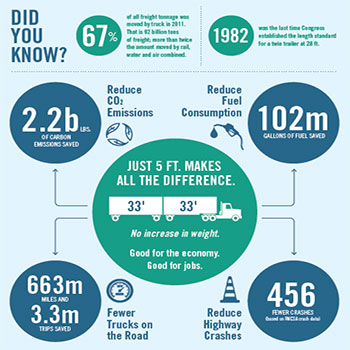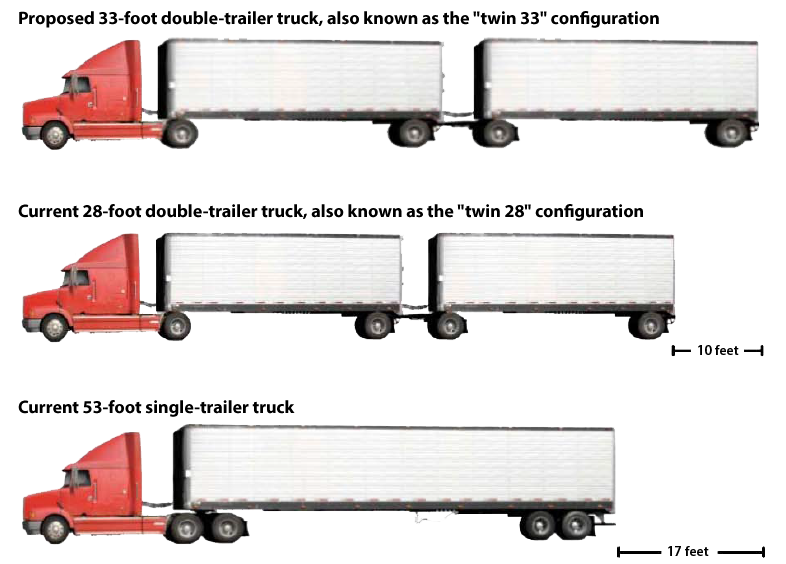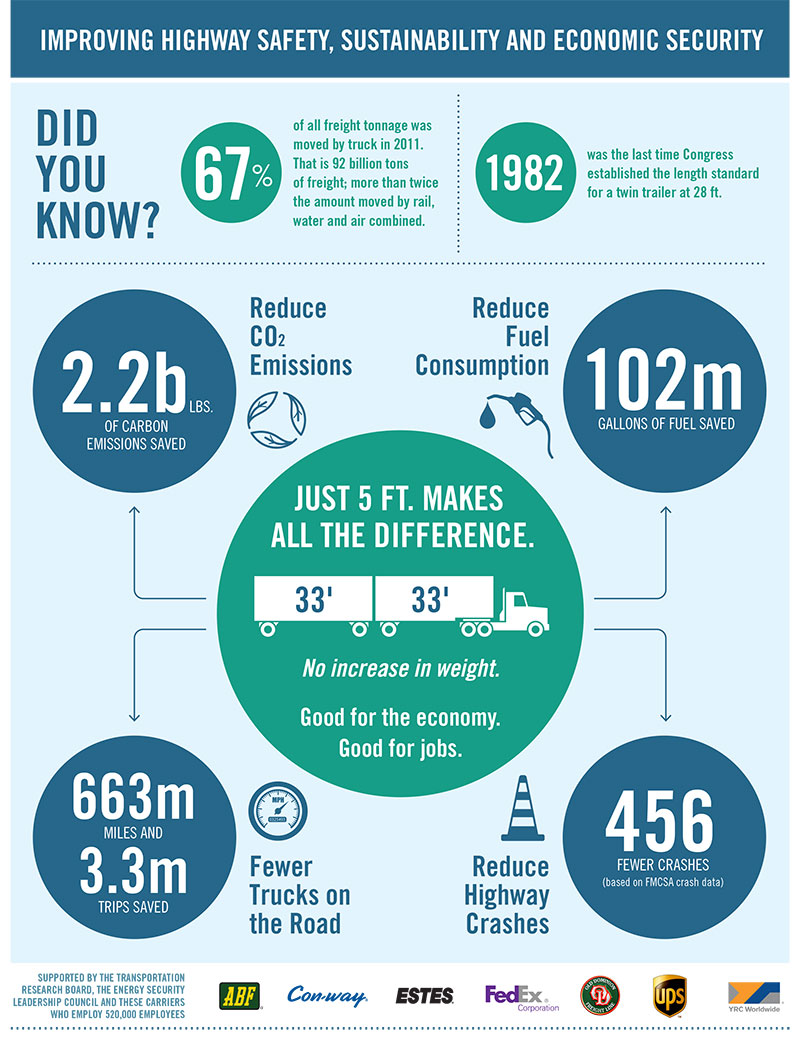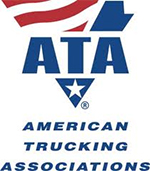Coalition for Transportation Productivity Asks Congress to Take Closer Look at Truck Size & Weight

The case against increasing truck size and weight has been built on the premise to keep bigger and heavier trucks off the road and apply existing federal truck size and weight limits to the entire National Highway System, rather than interstate highways, which is the case today.
This week, The Coalition for Transportation Productivity (CTP) a concern made up of roughly 200 United States-based manufacturers, shippers, carriers, and industry associations called on Congress to take a close look at data recently issued by the Department of Transportation (DOT) in its “Comprehensive Truck Size and Weight Limits Study, ” and focus on reforming Interstate vehicle weight limits for six-axle trucks.
The DOT study was a requirement of the current federal surface transportation bill known as Moving Ahead for Progress in the 21st Century Act (MAP-21).
The study’s objective, according to DOT, was to “conduct a comparative analysis of the impacts from trucking operating at or within current Federal size and weight regulations to trucks operating above those limits.”
DOT also stated, “attention is focused on six-axle tractor trailers and other alternative configurations,” and other factors, including: highway safety and truck crash rates, vehicle performance (stability and control), and inspection and violation patterns; pavement service life; highway bridge performance; and truck size and weight enforcement programs.
As previously reported, while the objectives of the study were ambitious, its findings did not yield anything of true significance, because of what DOT called data limitations.
Proposed 33-foot double-trailer trucks are much longer than today’s trucks
The proposed 33-foot double-trailer trucks are 10 feet longer than the ones they would replace, and are 17 feet longer than single-trailer trucks on the road today.
“Efforts to assess the full effects of the size and weight of various trucks are hindered by many of the same significant data limitations identified in previous studies,” DOT said.
“The Department finds that the current data limitations are so profound that no changes in the relevant laws and regulations should be considered until these data limitations are overcome.”
DOT said the data limitations include, as an example, a lack of descriptive information in crash reports, especially the weight of the commercial motor vehicle at the time of an incident, which undermines its ability to conduct highway safety and truck crash analyses. And the lack of weight data in crash reporting, the DOT explained, prevents it from knowing if trucks were fully loaded, at legal capacity for that axle configuration, had unevenly distributed weight or were running overweight prior to a crash.
CTP has a much different take on the differences, and related improvements that are based on actual findings from the DOT study.
In a letter sent to Congress along with a fact sheet comprised of key data points, CTP cited various “technical findings” from the DOT that show the safety benefits of heavier, six-axle trucks, coupled with reductions in logistics costs, pavement life-cycle costs, fuel costs, vehicle miles traveled, and related emissions usage.
“The actual study data provides strong support for allowing trucks equipped with six axles [traveling at both 91,000 and 97,000 pounds] to carry more freight on Interstate System highways,” wrote CTP Executive Director John Runyan in the letter. “This is the real message for Congress, despite the fact that U.S. DOT political leadership, after three years of study and 1,100 pages of released data, wrote a cover letter citing insufficient information and recommending against any changes in truck size and weight regulations.”
“While the Administration could not find a political path to support truck weight reform, we urge members of Congress to review the study findings for themselves and allow carefully crafted reforms in vehicle weight regulation to move forward.” Runyan stated.
And in the supporting fact sheet, CTP stressed that the DOT study found no appreciable maneuvering difference between five and six-axle configurations, with state-level empirical data showing that crashes involving six-axle configuration resulted in less frequently produced fatalities or injuries, which indicate a lower severity of crashes.
As for a material impact on modal shift from rail to truck, CTP stressed that the impact would be fairly minimal, explaining that based on DOT calculations, six-axle vehicles weighing 97,000 pounds and 91,000 pounds would divert $562 million and $196 million, respectively, from the $70 billion freight rail sector, with freight pegged to grow at about 2 percent per year, or 45 percent by 2040, and freight growth would be larger than rail diversion.
When the DOT study’s findings were issued in June, it was blasted by American Trucking Associations President and CEO Bill Graves.
“Given the timing of the release of this study, it is an obvious attempt to promote administration policy, rather than give Congress the unbiased information it requested,” he said in a statement. “It is appalling that after years of saying the study would not make recommendations, DOT officials would release this report – and recommend no change in current law – just days after the White House came out opposing truck productivity increases.
Our experience as an industry, as seen by the safe and efficient use of twin 33-foot trailers in the states of Florida and North Dakota, shows the obvious benefits of this configuration,” he said. “As flimsy as this report is, it at least acknowledges these more productive combinations will improve efficiency, saving American consumers billions of dollars.
Truck size and weight has long been viewed as a hot button issue in freight transportation and supply chain circles, as well as political ones, too. The case against increasing truck size and weight (TSW) has been built on the premise to keep bigger and heavier trucks off the road and apply existing federal truck size and weight limits to the entire National Highway System, rather than interstate highways, which is the case today.
And legislation in recent years that calls for not increasing TSW has included things like longer stopping distances, increased risks of rollover and trailers merging into adjacent lanes, with a 100,000 pound truck with unadjusted brakes moving 25 percent further after a driver applies brakes than an 80,000 pound truck and larger trucks representing a higher share of deaths based on miles traveled compared to standard vehicle traffic, as well as threats to the country’s roads, bridges, and other infrastructure.
“NASSTRAC has pushed hard for release of the DOT truck size and weight study, because of the importance of consideration of this issue in connection with the next Highway Bill,” said John Cutler, General Counsel for the National Shippers Strategic Transportation Council (NASSTRAC) and principal with McCarthy, Sweeney & Harkaway in Washington, D.C. “In addition assessing twin 33-foot trailers, which NASSTRAC supports, DOT could have looked to the multi-year pilot program in Maine, where allowing larger and heavier trucks on interstates has increased safety and improved productivity for shippers and carriers. Congress called for the study to get facts, not policy preferences of the Administration.”
Companies Who Support the 33 Foot Trailer Legislative Initiative
American Trucking Association | National Association of Manufacturers | NIT League | FedEx | UPS | AAA Cooper Transportation | ABF Freight System | Con-Way | Estes Express Lines | Volvo Trucks North America | YRC Worldwide | Old Dominion Freight Line
Article Topics
American Trucking Associations News & Resources
Trucking industry balks at new Biden administration rule on electric trucks: ‘Entirely unachievable’ Groups warn of $1 trillion cost for electrification of America’s trucking industry New coalition is focused on fighting new Labor Department independent contractor rule ATA data points to truck tonnage declines to start 2023 December Truck tonnage ends 2023 with a modest gain, reports ATA ATA warns of ‘tangled mess’ due to latest Labor Department independent contractor ruling November truck tonnage is down, reports ATA More American Trucking AssociationsLatest in Transportation
Talking Supply Chain: Doomsday never arrives for Baltimore bridge collapse impacts Amazon Logistics’ Growth Shakes Up Shipping Industry in 2023 Nissan Channels Tesla With Its Latest Manufacturing Process Why are Diesel Prices Climbing Back Over $4 a Gallon? Luxury Car Brands in Limbo After Chinese Company Violates Labor Laws The Three Biggest Challenges Facing Shippers and Carriers in 2024 Supply Chain Stability Index: “Tremendous Improvement” in 2023 More TransportationAbout the Author

















